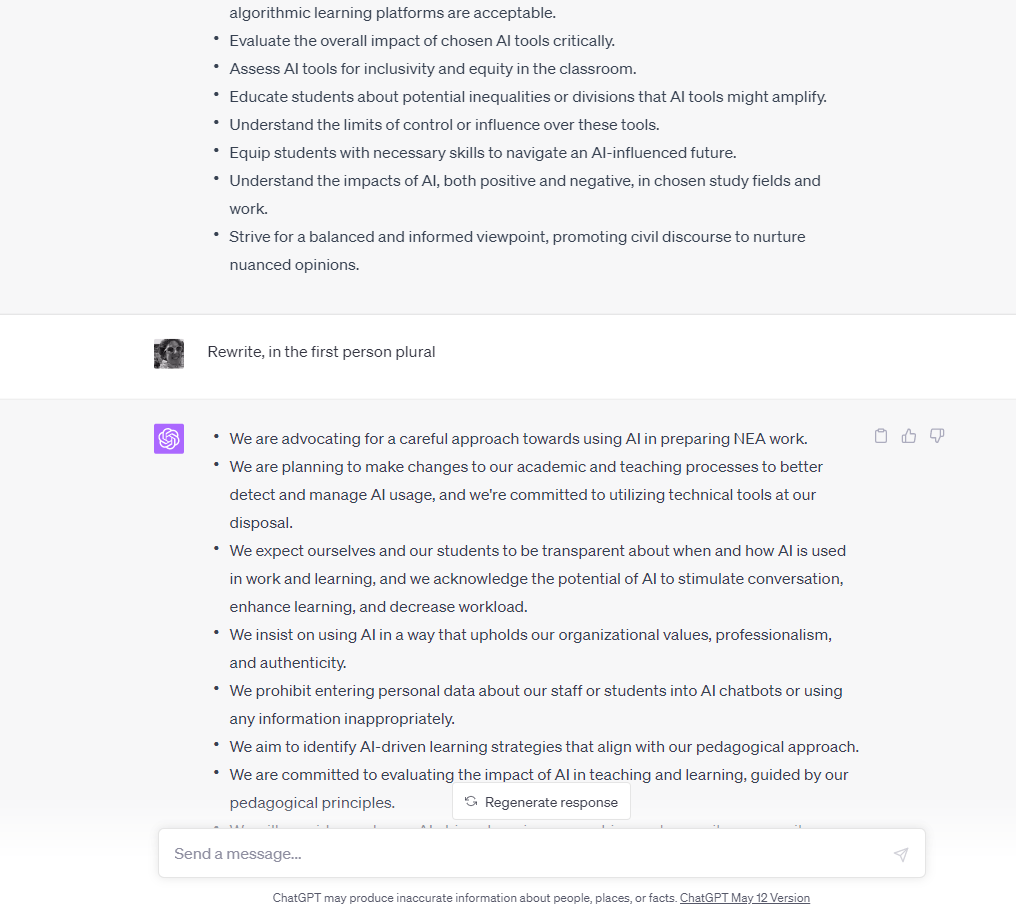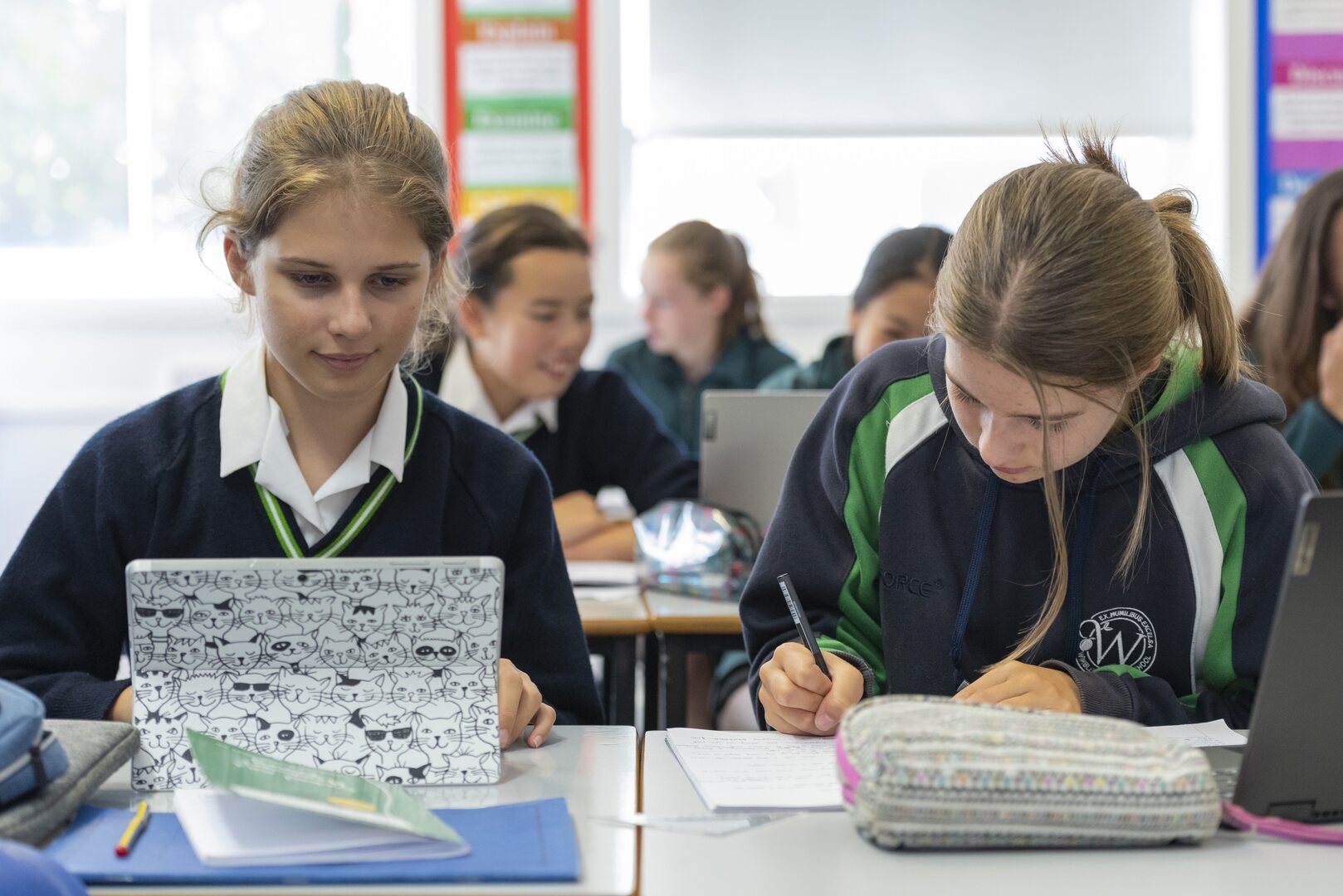In this week’s WimTeach, Rachel Evans (Director of Digital Learning and Innovation) sets out the school’s AI position.
Since I last wrote about AI and the advent of ChatGPT in January, we have researched, experimented and discussed the topic with colleagues, students, parents and experts. You may have seen that our Year 12 students, Lauren, Olivia and Rada, were featured in a recent article in the Financial Times (1): the journalist captured their reflections on their experimentation and use of AI so far. I feel the most important comment closed the piece –
“It’s so vital not to ban the use of it in education, but instead … learn how to use it through proper, critical thinking” […] Olivia adds. “Because it will be a tool in our futures.”
And, in short, that is what we shall be doing as we head into the next academic year. Suzy Pett (Director of Studies) and I have spent the past weeks researching and writing about our Wimbledon High position on generative AI. This short article summarises our thoughts, our red lines and our intentions.
Our position on the use of AI
PEDAGOGY
Our classrooms are intended to be places where dialogue and debate are at a premium, and where knowledge and understanding is constructed contextually and collaboratively among the thinkers in the rooms. – Suzy Pett
We believe that human connection is central to learning, and that metacognition is vital to students. We want to ensure that our use of AI extends students’ knowledge construction and communication skills, rather than undermining them.
In evaluating the use of AI we will bear in mind the intersection of the importance of human relationships and carefully constructed activities which benefit learning. A matrix such as the one below is helpful as staff and students experiment and evaluate.

- We will evaluate carefully the impact of using AI for teaching and learning, bringing our pedagogical thinking to the process.
- We encourage ourselves and our students to critically assess information generated and to be transparent about its source.
- We acknowledge the potential of AI to stimulate conversation, enhance learning and decrease administrative workload.
- We will critically evaluate the impact of AI tools. We aim to identify AI-driven learning tools or strategies that align with our pedagogical approach.
ACADEMIC INTEGRITY & SAFETY
Students’ assessment performance could be tested or confirmed using an oral examination; an approach which would also work within the classroom through a focus on oracy and dialogic learning. – Rachel Evans
We will work within national approaches for the use of AI in public examinations and welcome further clarification and thinking from government and national bodies. Within school, our teachers’ expertise and knowledge of each student, alongside technical solutions, can be used to guard against students using AI inappropriately in assessed work. A culture of honesty around the use of AI will be shared by students and staff alike. Data protection, privacy and cyber-security are significant risks which schools must manage; as we do at present in other areas of e-safety.
- We should take a risk-averse approach to the use of AI in the preparation of Non Exam Assessment work, while we await clarity on the Joint Qualifications Council guidelines for use.
- We should move to make some changes to our academic and teaching processes to reduce the likelihood of undetected use of AI and deploy technical solutions available to us.
- Staff and students should be transparent and honest when AI has been used in the preparation of work or resources. AI could be used to open dialogue, enhance learning or reduce workload.
- No member of the school community should enter personal data about staff or students into an AI chatbot or submit material which does not belong to them, or use age-inappropriate AI services.We follow the advice of the National Cyber Security Council on privacy and data protection.
EQUITY & JUSTICE
AI has the potential to level the learning playing field in our classrooms. An increasing range of digital learning tools utilise AI to allow all students to access materials and build confidence. – Suzy Pett
We know that critical evaluation of edtech tools, wherever possible including the students, is vital if they are to be effective in practice. We are excited by the potential for AI technologies to bring new approaches and opportunities for all students. We also hold in mind the risks of bias and inequality inherent in some technologies. We consider those students in our wider community who may not have access to this technology, and seek through our partnerships work to address this where we can. We hope that our students, educated about these issues, will be equipped to advocate for better governance as they ‘Stride Out’ from school.
- We are committed to ensuring that AI tools we use promote inclusivity and equity in the classroom.
- We aim to educate our students about the potential for AI tools to perpetuate inequalities or create divisions, in our own school and in the wider world.
FUTUREPROOFING
Recent research (2) suggests that many young people feel optimistic about AI and welcome a future where assistive technology will improve their working lives. However, the GDST Futures Report (3) paints a wider picture of concern about the future among young women; we must take care to balance these two viewpoints in our work with our students. – Rachel Evans
Students need to leave school equipped with resilience, mental agility and creativity to meet whatever lies ahead. Our contention is that we achieve this goal through an extension of our existing strategies to become a Hub for Innovative Teaching & Learning, and a Hub for Wellbeing. The human attributes of empathy, compassion, self-reflection, learning and creativity remain paramount in our practice of education and our hopes for our students.
- We are committed to equipping our students with the skills needed to navigate an AI-influenced future.
- We will strive to understand the implications of AI technology, both positive and negative, within our chosen fields of study and work, in order to better inform our students.
- We aspire to maintain a balanced and informed perspective about AI, promoting civil discourse to help our students develop nuanced opinions.
Acknowledgement:
The research paper which underpins this blog post was written by Suzy Pett and Rachel Evans. In preparing this article I have made use of ChatGPT Plus (GPT4) to assist in summarising and organising key points.

- The AI revolution already transforming education | Financial Times (ft.com)
- https://foundation.mozilla.org/en/blog/we-asked-people-around-the-world-how-they-feel-about-artificial-intelligence-heres-what-we-learned/ (accessed 22 May 2023)
- https://www.gdst.net/wp-content/uploads/2022/09/GDST_The-Girls-Futures-Report-2022_Final28.09-_WEB-Reduced.pdf

